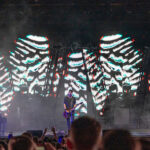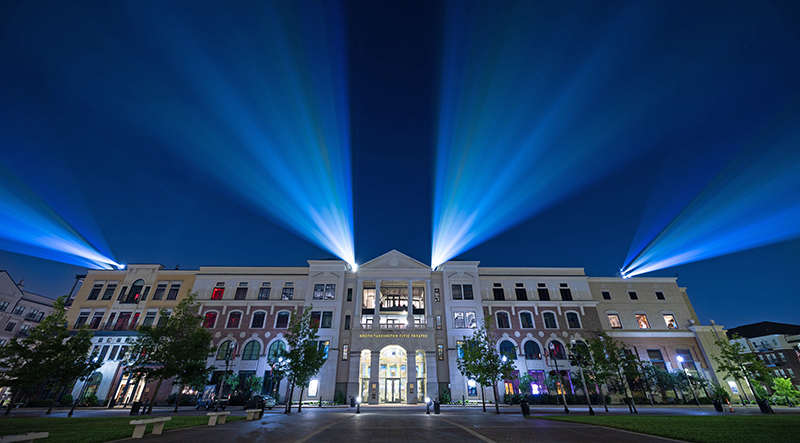
Blockhouse Studios creates the Palladiscope, a permanent projection mapping installation system
Located in Carmel, IN, The Carter Green Palladium is the flagship venue of the Center for the Performing Arts complex. The Palladium building, which houses a 1,600-seat concert hall, is a striking presence with its domed, neoclassical architectural design. It has now also been transformed into a canvas for a permanent projection mapping installation. The city of Carmel and the Carmel Redevelopment Commission approached Blockhouse Studios, a bespoke multimedia production company based in Bloomington, IN, to create a one-of-a-kind, permanent viewing system for architectural cinema at the Carter Green Palladium. They wanted projection mapping to highlight the building’s architecture with a narrative-based show.
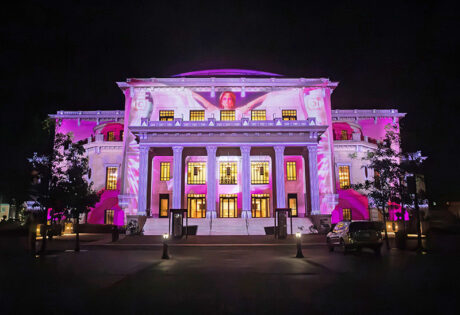
Art and Architecture
The first projection-mapped art installation, EOS: The First Dawn, launched on Aug. 31, taking visitors through a serene and compelling visual experience with breathtaking projection mapping and illuminated effects. The EOS installation features theatrical storytelling that’s inspired by astrological concepts and the elemental themes of nature. It was inspired by the classical temple architecture of the ancient Greeks and Romans, an influence on the Palladium’s architectural design. Blockhouse’s work skillfully combines inspiration from centuries-old architecture with a modern projection experience.
Breathtaking colors and content transform the building with mesmerizing projection, immersing the audience in the story of the three children of Titan: Selene, the goddess of the moon flying across the sky; Eos, the goddess of the dawn summoning the sunrise; and Helios, the joyous rising sun god. EOS: The First Dawn is a 12-minute show, over the course of which it cycles from night to dawn to day. Then are credits followed by 18-minutes of gradients that project on the building in similar colors and tones as the EOS show. This nightly loop begins at 9 p.m. and continues until 11 p.m. The system is designed so that new content can be added at any time, and the facility staff can always bypass or change up the playback for special events.
Projecting Lumens
In designing the permanent projection and control system for the Palladium installation, the Blockhouse team deployed 12 Epson EB-PU2220B 20,000-lumen large venue laser projectors. The permanent projection system lights up the 151,000-square-foot Palladium with 240,000 lumens of brightness from the Epson projectors. The projectors are mounted in enclosures on the roofs of nearby buildings that are also part of the Performing Arts complex with the Palladium.
“So much goes on behind the scenes for a project like this, from concept and design to animation and post-production, to actual onsite mapping and rigging of the projectors,” comments Kevin Winkler, Chief Innovation Officer/Founder, Blockhouse Studios. “Our team worked for months on this project, as we wanted to create a visually stimulating experience that would blow viewers away. We focused on next-level cinematic detail and storytelling beyond what is typically expected of outdoor entertainment in a very intricate web of elements and design. Every piece of content was carefully thought out and created using our own in-house special effect tools along with real actors and green screens to truly bring the story to life.”
Blockhouse created 3D scans of the Palladium building as the basis to work from. “We create our own photogrammetry scans of the building,” says Winkler, referring to a method of approximating a 3D structure using two dimensional images. “We do our custom 3D model unwrap and spend a lot of time making our template file, because we do ours a little bit differently. I wanted to build a pipeline that our designers are not limited by. A lot of projection mapping pipelines leave a lot up to 3D designers. Our method leaves it open to everyone. Most of our teams are fluent in [Adobe] After Effects, so we do a lot of in-camera and practical effects, like clouds and things like that.”
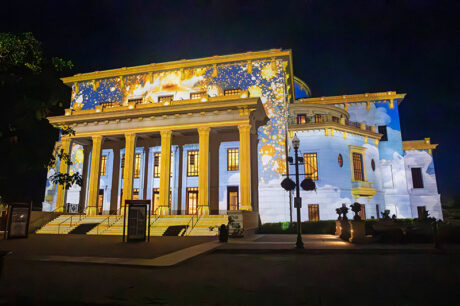
Creating the Palladiscope
A custom-made, audio-visual system, built and named by Blockhouse Studios, the “Palladiscope” needed projectors that could deliver an immense amount of brightness with vibrant colors and the ability to withstand extreme weather conditions. Winkler adds, “In addition to all our hard work, it required technology that could reproduce the content how we intended it to be viewed. With bright colors and sharp details to ensure the building’s architecture was highlighted, a story was told, and viewers were engaged on many levels. We wanted that ‘wow factor’ and the Epson projectors delivered at this massive scale.”
Powered by 12 Epson EB-PU2220B projectors, the Palladiscope was built to take traditional content viewing beyond a screen and onto the physical architecture of the Palladium. The creative team chose Epson’s ELPM11 lenses for this projection system. Winkler explains further, “As a permanent install, we knew we needed to approach the system design in a different way than other outdoor architectural projection projects, which are almost always temporary installations. To that end we developed the Palladiscope system to interface seamlessly with the existing control systems on site, including lighting, scheduling, audio, and more. And to ensure the system was robust and easily serviceability, we consciously avoided custom software and hardware. We’re using MadMapper as our control software. It’s hyper lightweight and plays back our 15,600 by 2,600 ProRes file perfectly.” Other members of the Blockhouse Studios team for the Palladium project include Lead Designer, Amelia Morris, and Project Manager Jane Chambers.
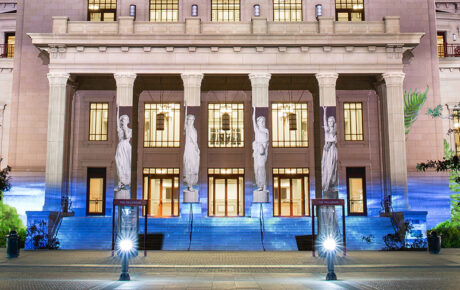
Climate Control
As the Palladium project is a permanent installation, outside in all four seasons with Midwest weather, the 12 projectors need projection from heat, cold, moisture, and dust. “There’s a lot of architectural projection projects out there,” said Ramzi Shakra, Senior Product Manager, Epson America, Inc. “I think what made this one extra interesting for us, on the Epson side, is the fact that it’s a year-round permanent installation. It’s not a quick drive-in, do three days for a festival, and then leave. The fact that it’s a permanent install really added to the complexity and sophistication. And, why obviously the Tempest enclosures were needed when you’re thinking about something that’s going to stay outside in all kinds of weather for five or more years.”
The projector content is controlled by MadMapper software and each projector is mounted in a Cyclone enclosure from Sun Valley, CA-based Tempest. Designed for large format video projectors delivering between 20,000 to 40,000 lumens, in any climate, the state-of-the-art Tempest Cyclone enclosures are engineered to ensure the projectors always operate at peak performance. These enclosures are installed on the roofs of the James and Tarkington buildings, adjacent to the Palladium, along with a custom-designed technology room that houses the server that feeds the video content to the projectors. The Palladiscope runs on a nightly basis throughout the year.
While Blockhouse has done several projection mapping shows at other locations that are tied to the season, “this show is something that is agnostic to the season,” explains Winkler. “We are currently working on other shows for other seasons, but EOS is one that we can always go back to and can play at the in-between times since it’s tied into the Greek architecture of the building and the events that go on at the Palladium, which has orchestras, ballets, and bands. Our show encompasses that with Selene, our moon goddess, who is an aerialist; Eos, our main character is a dancer; and Helios is a local musician in Bloomington who is in a band. Each one of those characters represents the types of things that go on at the Palladium and celebrates the performing arts.”
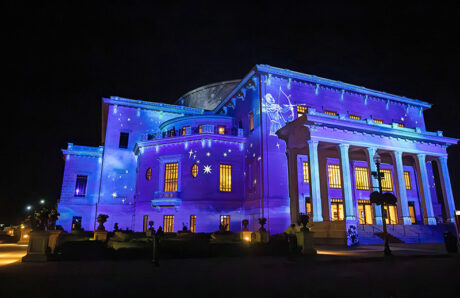
Challenges and Solutions
There were a few challenges that needed to be dealt with by the Blockhouse Studios team. Winkler discusses these challenges and some of their solutions. “The building is fairly three-dimensional, it’s not super flat like other projects where they are essentially one plane. The more depth you get, the tougher projection mapping can be to cover all the surfaces. So, there was a little bit of extra work to figure out, getting those projectors on the far outside to cover some of those deep corners. It’s at the tightest tolerance of what you can do from those angles. We were down to the inch. We did some really creative tiling with those projectors that is not super common. This project calls for a super tight tolerance because every triglyph and architectural detail—all those little things across the top of the building, every one of those is traced in our show file. We did things in our show file that most people wouldn’t even really attempt to do because it makes the alignment hard. It means every single brick has to line up. It is very, very tight. One of the biggest challenges, I think, was just making sure that our pipeline was right from start to finish with those types of design tolerances. That was probably the hardest part.”
One fact about the building helping the Blockhouse team is that it’s limestone, which is highly reflective and great for projection mapping. At approximately 350’ away from the Palladium is the Booth Tarkington Civic Theater, which is the rooftop where the Tempest enclosures and Epson projectors are mounted. “We were lucky enough to have the Tarkington Theater on the other side,” says Winkler, “so we could spread our projectors across and get pretty good coverage of the building.”
The Blockhouse Studios team has done an excellent job from the creation of the projection mapping show to the creation and realization of the projection and control system for the Palladium. “We really consider our shows architectural cinematography,” states Winkler, “and I think we have a very unique team that lets us put our emphasis on practical effects, be obsessive about details, and having a lot of resolution on our buildings. When I’m working with the team to make a show, our goal is to do something that people haven’t seen. When we launched this show, we had a lawn full of people, and the first play through, the audience was engaged and nearly silent—that was when I knew we had done our job. There’s something that they can’t put their finger on about our shows that looks different than the other projection mapping content they may see out there. I am proud that that sets us apart.” Epson’s Shakra agrees it is a crowd pleaser and concludes by saying, “The amount of time, talent and effort that went into this project is remarkable, from Tempest to Epson to the Blockhouse teams. To see it in real life at its actual massive scale—it is nothing short of amazing, and all of us at Epson are thrilled to be part of it.”

